Click On Image
For Full Size Image |
Size |
Image Description |
Source |
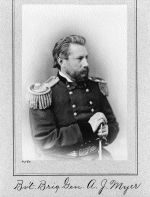 |
191k |
Namesake
Albert James Myer—born on 20 September 1829 at Newburgh, N.Y.—received his bachelor's degree from Hobart College in 1847, graduated from Buffalo Medical College in 1851, and became an assistant surgeon in the Army on 18 September 1854. Already an accomplished telegrapher, he became an enthusiastic proponent of visual signaling while serving in Texas. In the late 1850s, Myer lobbied vigorously for the adoption of his method of signaling and for the establishment of an organization within the Army responsible for communication. In 1860, Congress created a major's billet on the Army staff for a signal officer, and Myer was appointed to fill the new slot. Between the summer of 1860 and the spring of 1861, he employed his system successfully during General Canby's campaign against the Navajo Indians.
In June of 1861, Maj. Myer received orders to Washington, D.C., to organize and command a signal corps. Through the first two years of the Civil War, Myer carried out both administrative and operational responsibilities while also proselytizing in Washington for the establishment of the Signal Corps as a permanent entity in the Army. Brevetted a lieutenant colonel on 27 May 1862 for his service on the staff of the Army of the Potomac, he received a full colonelcy as a result of the formal establishment of the Signal Corps on 3 March 1863. However, conflict between Myer and the assistant secretary of war under whose supervision military telegraphy fell, resulted in his removal as chief signal officer in -November 1863 and his assignment to the Military Division of the West Mississippi in which he served the remainder of the remainder of the Civil War.
Following the war, Myer received the brevet rank of brigadier general; but he did not really come into his own until July of 1866 when Congress reorganized the Signal Corps and, with the permanent rank of colonel, he again became chief signal officer. Myer headed the Signal Corps from 21 August 1867 until his death at Buffalo, N.Y., on 24 August 1880. During that time, he played a dominant role in the resumption of a storm warning service that previously had been provided by the Smithsonian Institution and its subsequent incorporation in 1870 as the United States Weather Bureau under the direction of the Signal Corps. Myer became a permanent brigadier general on 16 June 1880, a little over two months before his death. Fort Myer—in Arlington, Va.—is also named in his honor.
Digital ID: cph 3c10271 Source: Library of Congress |
Bill Gonyo |
 USACS Albert J. Myer USACS Albert J. Myer
|
 |
67k |
USACS Albert J. Myer under way, date and location unknown. |
Joel Osterberg RMCS USN Ret. Mil Det USNS Albert J. Myer, 1987-99 |
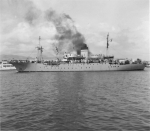 |
485k |
USACS Albert J. Myer under way, date and location unknown. |
Ron Phillipi |
 USNS Albert J. Myer (T-ARC-6) USNS Albert J. Myer (T-ARC-6)
|
 |
141k |
USNS Albert J. Myer (T-ARC-6) under way, circa 1968, location unknown. |
©Ramon Jackson |
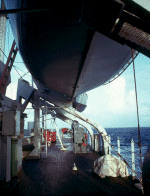 |
138k |
 |
43k |
USNS Albert J. Myer (T-ARC-6) at sea during chart transfer, Pacific Ocean, 1967. |
©Ramon Jackson |
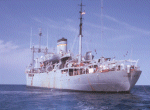 |
69k |
 |
695k |
USNS Albert J. Myer (T-ARC-6) berthed at No.9 Berth, Barry Docks, Wales, Great Britain, 30 July 1973.
Photo source "Barry
Heritage Collection" courtesy Terry Spierling. |
Terry Spierling |
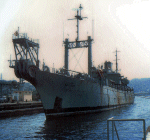 |
158k |
USNS Albert J. Myer (T-ARC-6) entering a harbor in Japan circa May 1976.
Photo by Dave Marr. |
Robert Hurst |
 |
118k |
USNS Albert J. Myer (T-ARC-6) at sea, date and location unknown. |
Ramon Jackson |
 |
61k |
USNS Albert J. Myer (T-ARC-6) under way, date and location unknown.
US Navy (MSTS) photo. |
Robert Hurst |
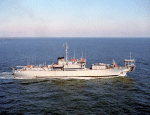 |
2092k |
USNS Albert J. Myer (T-ARC-6) under way, 1 January 1984, location unknown.
U.S. DefenseImagery photo VIRIN:
DN-SC-85-08565 |
Robert Hurst |











